The confluence of NIKE and Theravada Buddhist ordination is perhaps a rare occurrence. Yet the famous sports slogan once helped a young woman at a crossroads make the choice to shave her head, give up her possessions, and devote her life to the liberation of all beings.
Venerable Ayya Tathaloka was then aged 19 and a student of pre-naturopathic medicine in Portland, Oregon. She had meditated independently for a long time, and had heard the Buddha’s Four Noble Truths in the context of medicine. For her, the Buddha’s words seemed to mirror a doctor’s aim: to find the root of suffering and alleviate it. She and her fellow medical students “were idealistic, but we didn’t know anyone who had really been able to accomplish our goals,” she says.
FEATURES|COLUMNS|Women in Buddhism (inactive)
Offering Welcome: Ayya Tathaloka
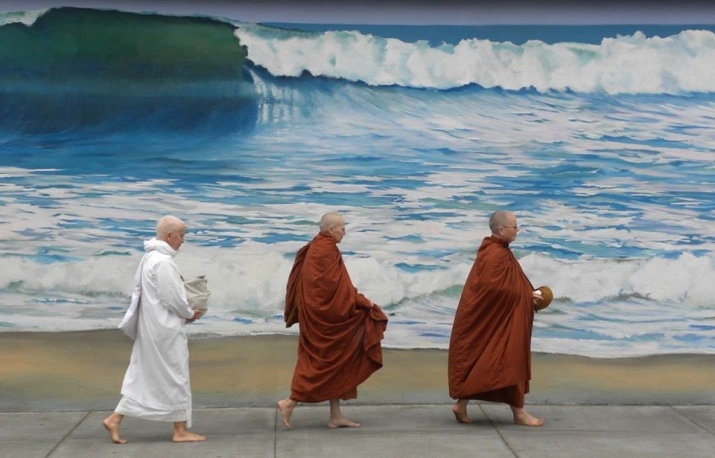 Dhammadharini bhikkhuni on alms round
Dhammadharini bhikkhuni on alms round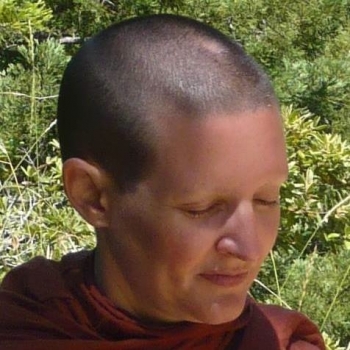
The young medical student began to wonder if her future lay not with medicine, but with Buddhism. As she made her way through the winter streets of Portland, she kept thinking she saw the bright saffron of Thai monastics against the snow: “I would catch glimpses of robe color out of the corner of my eye and I would feel my heart tug and pull,” she says. That winter, on the sides of buses, on billboards, everywhere was the brand-new NIKE slogan: JUST DO IT.
And so she did. She left college and became a “Dharma bum” for a while, traveling around Asia “to see if it was possible to live without regret and without compromise.” Ayya Tathaloka (also spelled Tathaaloka) became a fully ordained bhikkhuni in 1997, and went on to found the first Theravada bhikkhuni monastic community in the western United States. Since that time, she has established places of refuge, practice, and study for Theravada Buddhist women. Once inspired to wander in search of the truth, she is now a leader in helping other female monastics put down roots. This month, she and her sisters will finally be opening a permanent home in northern California for Dhammadharini, the space for female Dharma seekers they have been developing for over ten years. There, they will continue the work of training and ordaining new generations of women monastics.
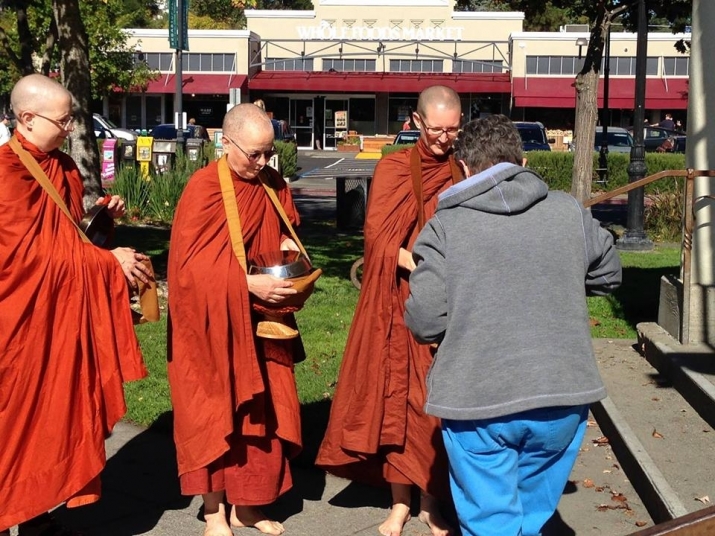 Bhikkhuni alms round
Bhikkhuni alms roundOf course, it wasn’t just NIKE that prompted Ven. Tathaloka’s decision. The girl then called Heather Buske had always been intrigued by Buddhism. As a child, flipping through the pages of National Geographic magazine, she had been entranced by images of a robed monk stepping across a bridge in a jungle. At summer camp, she had learned to meditate by age 10, simple techniques that she credits with carrying her through the tumult of adolescence. Media such as the TV show Kung Fu, the fantasy book The Lord of the Rings, and the Star Wars movies imbued in her an interest in seeking a spiritual path and “purifying the heart” in way that could serve the larger world. “The paradigm of the wandering seeker was really strong for me,” she says.
After many years wandering and training in Asia, she was finally ordained in California. At that time, she was one of only a few Theravada bhikkhuni in the US, she says. She began to see how important that was for the lay community.
“Having a bhikkhuni present in this role was something very unique and very beneficial to them,” she recalls. “Then there were the monastic life aspirants, who really wished also to be able to go forth, to train, and to ordain.”
Encouraged by mentors, including a Korean bhikshuni, supportive male monks, and elder teachers, in 2005 she established Dhammadharini, a women’s monastery, in the San Francisco Bay area. Because the sisters lived on what was offered to them, they often changed location—but the intention to create a welcoming practice space was always there.
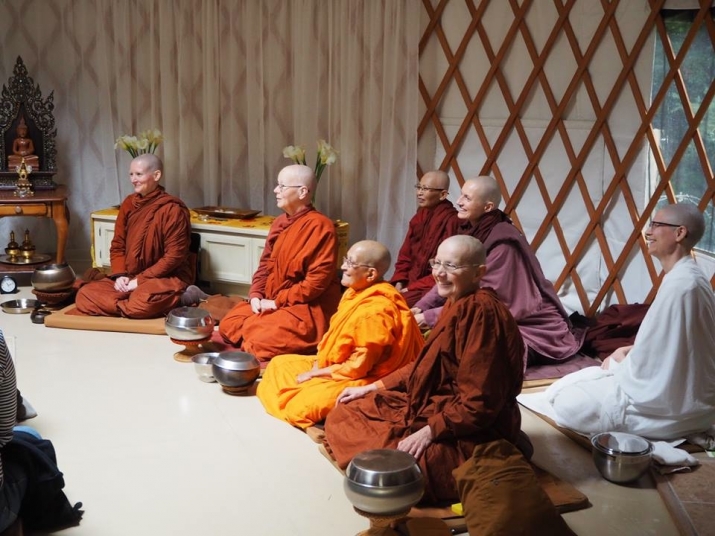 Ayya Tathaloka and bhikkhunis
Ayya Tathaloka and bhikkhunis“In the beginning, most profoundly, every time it was possible to give encouragement rather than discouragement and spread within our community that sense of possibility, we did,” she says. “Even from opening the doors of the very first Dhammadharini in this tiny, tiny place next to the train tracks, at what could be called the bad end of town . . . Still, we were able to open the doors and say, ‘Welcome, you are welcome here.’ ”
Welcoming women into the ranks of monastics is part of the Buddha’s teachings, says Ayya Tathaloka. “Women say that when they aspired to monastic life and then they found out they couldn’t ordain, it was one of the most deeply disappointing things of their life, and counter what is fundamentally in the Buddha’s intention and the Buddha’s way,” she says. “They say that you get over it, but then also they say there’s a way in which you can’t ever really get over it.”
Ordination for women has caused disagreement in Theravada lineages. Because the original bhikkhuni lineage has been lost, many feel that full ordination is impossible—and yet ordination has proceeded in some countries, notably Sri Lanka. The topic remains controversial. In 2009, Ayya Tathaloka served as preceptor for a bhikkhuni ordination ceremony in Perth, Australia overseen by Thai Forest Tradition teacher Ajahn Brahm, who was expelled from the lineage as a result of the event.
Part of reviving the global bhikkhuni sangha is telling the stories and history of Buddhist women, a task to which Ayya Tathaloka has devoted much of her research. “There is such a strong sense of disconnect” with the historical Theravada bhikkhuni sangha, she says. By delving into the oral tradition, art, poetry, chanting, and written records of various Buddhist lineages, she hopes to reestablish a connection between the ancient female monastics and the modern day. Grounding the community in Buddhist women’s history—or as Ven. Tathaloka calls it, her-story—will be one of the new Dhammadharini’s goals. Whether chant, sutra, or oral tradition, “it all helps to make the bridge,” she says.
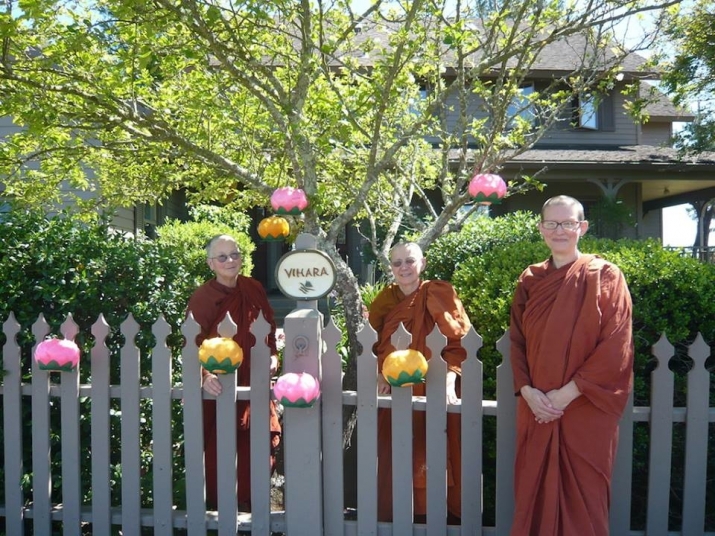 Dhammadharini Monastery gate
Dhammadharini Monastery gateDhammadharini has shuffled around a lot through the years, taking advantage of donated spaces. Eventually, the nuns found refuge in the Sonoma coastal forest at Aranya Bodhi hermitage. The ruggedness and remoteness of the hermitage made it beautiful, but also untenable for lay practitioners who lived in the city. In addition, the aging of some bhikkhunis meant that being so far away, camping in the redwood trees, was not always practical. Although they still maintain the hermitage, the community began to look for a permanent home that would be more accessible. This year, they found one—the new monastery will be their sixth space, but the first one actually owned by the community, rather than rented, borrowed, or “gift of use.”
The new Dhammadharini center will hold its opening ceremonies on 16 and 17 July. Getting everything ready, including renovations on the building (“it’s a fixer-upper”), made spring a busy time for the bhikkhuni. However, the motivation has been strong. “Even though it’s much nicer to have a life that’s not so full of busy things like starting a new monastery, it feels worth it because I deeply know and sense the benefits,” Ayya Tathaloka says. A wandering seeker she might have been, but now she is able to invite other seekers into a safe and welcoming place. “For the new monastery, I have a very deep sense that this is going to be good for our community. It seems like a good time to be putting down roots here,” she says.
See more
Dhammadharini
All images courtesy Dhammadharini
Look out for Ayya Tathaloka’s article on the 2600-year anniversary of the worldwide bhikkhuni sangha on Buddhistdoor Global this September!














